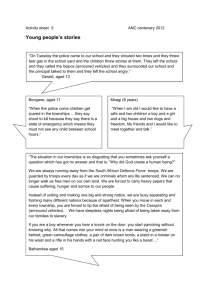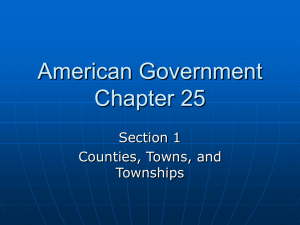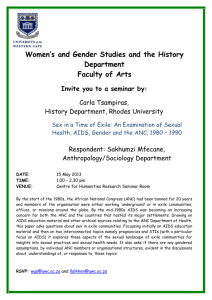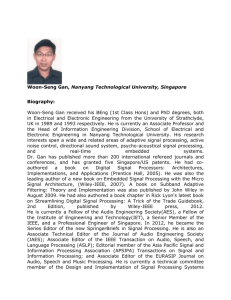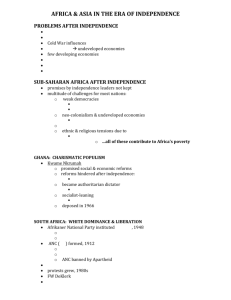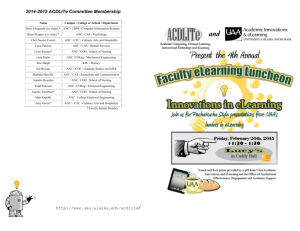Anti-Apartheid Movement in South Africa
advertisement
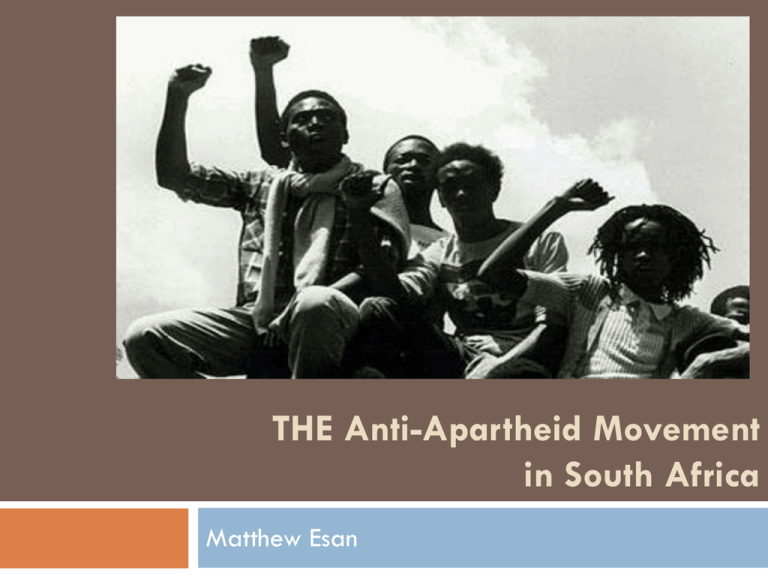
THE Anti-Apartheid Movement in South Africa Matthew Esan WHITE SUPREMACY & BLACK RESISTANCE White Supremacy & Black Resistance Dutch colonists first embarked on the Southern tip of Africa in the 17th century, immediatepushing aside the natives and assertng their racial supremacy. Racial attitutes would not change through the centuries, and a explicit policy of segregation was adopted in the 1920s, with aparthied coming in full force in 1948 with the elction of the racist National Party. The state went about setting up reservations in which each African nation was to develop its own society – the aim was to keep the races as separate as possible. 80% of South Africa, including the major cities, ports, industrial areas, and prime farmland, became the homeland for Europeans, of whom accounted for merely 20% of the population. Hendrik Verwoerd – social zoology. He studied in Gemrnay where he was exposed to Nazism. Upon becoming PM in 1958 he sought the maintain white supremacy ‘by force if necessary.’ Interracial relatonships banned between races. Chruches, theatres, transport, schools and so forth were segregated. Weaknesses within the segregation framework South Africa was not self-sufficient. The wealth and muscle of SA depended on fruitful ties with the rest of the world. Segregation and White hegemony could only be maintained so long as key internaitonal trading partners were willing and prepared to do business with a state embedded in such views. Also, the state relied on the cooperation of critical number of blacks to help control the homelands. Furthermore, the mines, factories and farms , that kept South Africa going, could only function if millions of blacks did the majority of the manual labour – blacks HAD to use their economic power to challenge and overhaul the system form whithin. EARLY RESISTANCE Early Resistace Gandhi led many campaigns beginning from 1907 in the fight against racial inequality & discrimination. He and his followers conducted strikes, mass illegal border crossings and burned registration cards, causing the gov’t to abrogate some (not all) of their oppressive laws. In the following decades Africans, Coloureds & Indians established groups like the Africa National Congress (ANC) to represent their interests. The ANC aimed initially to use legal, respectable means to challenge the state. The racist ‘National Party’ came to power in 1948, and the ANC responded by moving toward popular mobilization. Used nonviolent tactics such as violating curfews, segregation and other ordinances. Their efforts weren’t successful however and many went to jail, causing the ANC to call off protests as 1) they lacked substantial support from whites & 2) more repressive laws, such as that allowing the whipping of protesters, were enacted. Few success cases early on – the Federation of Africa Women in 1955 using nonviolent methods to get a law repealed that required all women to carry passbooks. Clearly there was potential. Early Resistance ANC splintered in 1959. Dissidents rejected the ANC’s principle of forging alliances with whites and set up their own group, the Pan-Africanist Congress (PAC). In early 1960, they called on Africans to go to police stations without their passbooks and let themselves be arrested. This led to the famous Sharpeville Massacre in which the police opened fire ito a crowd of 5000, killing over 70. The sharpeville massacre sparked weeks of protest, strikes & riots around the country. The state would retaliate, arresting a grand total of 10,000 protesters. The ANC & PAC were subsequently banned. African leaders forced to work underground. Some, including Mandela become disillusioned with nonviolent efforts. Mandela quoted this old proverb at a meeting - ‘the attacks of the wild beast cannot be averted with only bare hands.’ ANC subsequently formed an armed, more violent wing – Umkhonto we sizwe (spear of the nation), though there efforts were not successful. ‘TO HELL WITH AFRIKAANS’ ‘TO HELL WITH AFRIKAANS’ Black Consciousness – Steve Biko its most prominent advocate emancipation must emanate from the minds of individuals. Blacks had to liberate themselves from the institutionalized system of white superiority that had been hammered into them in schools, history books, the white media and so on, in order to achieve full freedom. Attracted many young people who grew up in cramped and deprived townships – very angry – believed the school system was merely a tool to prepare them for obedient service to white employers. One morning they marched toward the center of town and then a police station carrying signs such as ‘to hell with Afrikaans.’ The police shot off tear gas. The students held their ground, but the police proceeded with brute force, killing a thirteen year old boy. ‘TO HELL WITH AFRIKAANS’ They protesters proceeded to smash windows, and set vehicles, schools and gov’t buildings on fire, the police, all the while, still ruthlessly opening fire. After 3 days of rioting/rifling 60 rioters were dead. This spurred several more violent uprisings in townships across South Africa, with students at the nucleus. The death toll would reach a grand total of 1,149, only five of whom were white. September 1977 saw the death of Steve Biko due to brutal police treatment - crushing blow to movement. Militant/Violent efforts clearly futile. Although the black consciousness movement succeeded in freeing blacks from a mindset of racial inferiority, it had no broader plan for overcoming the white political oppressive regime as a whole. The Civic Movement The Civic Movement Militancy clearly wasn’t working. Many now turned to tackling the day-to-day issues that were ‘essnetial, real and vital’ and paramount in giving people the power to believe they cold effect change, thorugh mass action, on local issues. HOUSING - Townships all over the Transval provinCe began organizing and restricitng rent hikes & campaigning against the destruction of squatter settlements using public demonstrations, rent boycotts etc. The Port Elizabeth Black Civic Organization (PEBCO) was set up to represet all the city’s townships. They made inroads – got rent hikes canceled & won a repreive for a condened township by threatenenig a boycott on busses & white businesses. The Civic Movement TRANSPORT – A bus fare increase in Lamontville sparked an 18 month boycott. Minibusses driven by township people shuttled workers to their jobs, and the buss system was forced to back down. In several townships people were using disciplined nonviolent actions to put pressure on local councils. One newsletter in 1982 stated that ‘due to constant pressure the Divisional Council has finally woken up…more roads are being built, street lights erected, sewerage pipes laid’ etc. Instead of defying the regime steeped in its own orthodoxy and capable of repression, they instead opened up room for independent action within the state. Tackling local greivances was intended to be a basis for wider resistance and galvanizing as many as possible before presuming to challenge the existing political structure. ‘WE WANT ALL OUR RIGHTS’ ‘We Want All Our Rights’ ‘From that base of first-level grassroots rganization…we can start to build progressively more political forms of organization – a process which would culminate in the development of a national democratic struggle…’ MOLEFE 1982 Prime Minister P.W. Botha proposed a new parliametn of three seperste chambers – one each for white, coloured & Indian representatives. Africans being denied any role whatsowever. Attempt to schismatize the movement by dividing interests and thus thwarting the movement’s progress. However, this led to the mobilization of a massive united front, composed of‘churches, civic associations, trade unions, student organizations, sports bodies’ and so on. The Uited Democratic Front (UDF) was lauched in 1983. It wa composed of people from over 500 organisations with one key goal (as articulated by the movement’s founder Allan Boesak), ‘we want all our rights, and we want them now.’ They were accepting of whites who wished to join their cause – ‘morally indefensible’ to exclude them. ‘We Want All Our Rights’ The UDF had many notable church firgures, such as Desmond Tutu, of whom argued of the moral indefensibility on religious grounds of white supremacy. Tutu was an articulate and genial figure who many South Africans wormed too. When he won the Nobel Peace Prize in 1984, he became virtually untouchable by the regime. The UDF claimed kinship with the legacy of the ANC, which was important because their militant wing and the very inconic status of the some of their leaders held in prison on Robben island had garnered mch support for the group from blacks. SPONTANEOUS WAVES OF MILITANCY SPONTANEOUS WAVES OF MILITANCY A tougher economy had brought on new hardships and young people were beginning to boycott schools again and were injecting new volatility into the struggle. Civics gradually bcame overpowered by those who wanted to rapture, not just pressure, local authorities. Violence spread acorss many townships acorss South Africa by 1984. In Sharpeville, for instance, when a corrupt councillor anounced a rate increasee, protesters set him ablaze. In one township after another, conflict over local issues erupted into riots, arson, police massacres and hundreds of horrific killings perpetrated by both sides. The practice of ‘necklace’ became common in many townships. This involved stabbing an aparthied collborator, stacking tyres around his shoulders and head, setting him on fire and watching as they burned to death inside them. The violence was so fearsome that councilors and police in some townships fled altogether, taking refuge in guarded, barbed wired compounds. SPONTANEOUS WAVES OF MILITANCY By May 1985 257 councillors had resigned and authority in the townships had collapsed entirely. Gov’t declared a state of emergency in 1982, with the State Security Council delegating martial law powers to police and soldiers. In the 8 months after the state of emergency was declared, at least 8000 people were detained without any charges, most of them leaders of the UDF. The UDF did not condone such violent actions, but found it very difficult to respond effectively to the waves fo militancy around the country. Echoing Gandhi, Desmond Tutu insisted that the struggles’ methods had to be consistent with its ends. PEOPLE POWER People Power Mkhuseli Jack aka Khusta Jack, emerged as a leader of those seeing an alternative to the violent uprisings. He believed that many previous uprisings failed as small organisations merely served to rouse the people, and had no effective plan thereafter. He wanted to build a strong organisation outward, that trough many ‘cadres.’ This would be very difficult to crush, he believed, as there would be ‘big centres of resistance within the community.’ In May 1985, Jack became the spokesman for a boycott of white communities in Port Elizabeth. This was very effective with White-owned stores losing, on average, 30% of their business. A white member of parliament called the boycott ‘one of the most effective weapons…that blacks have found for some considerable time.’ Jack, tore up his banning orders at a giant rally where people were mobilized thus to resume the boycott 9 days later. The renewed boycott was even more disciplined and organized than the 1985 effort. People Power The mass organizing of the UDF, and the effective leadership of Khusta Jack had managed to harness the hearts of black youth and and also older citizens. Also, in relation to the power vacuum that erupted in the townships due to violent uprisings, this allowed UDF members to encourage committees to adopt the principle of ‘people power’ in that people were beginning to organise democratically to fill this vacuum. ‘People were beginning to ‘exert control over their own lives …beginning to govern themselves, despite being under racist rule.’ The regime responded with more aggression however. The President declared a second state of emergency in June 1986. 25,000+ were arrested and imprisoned without trial; censorship regulatins barred the media from the unrest within the country; the regime forbade any nonviolent action, in fact prohibiting the UDF and other groups from any action at all and covert operations were mounted against opposition leaders includings break ins, bombings & assasinations. The regime was desperate and even tried making service and infrastructure imporvements too, in order to pacify those it had held down. What was becoming increasingly clear was that ‘people just didn’t want aparthied anymore. They were not prepared to be suppresssed anymore.’ ROAD TO FREEDOM Road To Freedom International repercussions – 1985, President Regan had issued an order imposing limited sanctions on South Africa. The following year Congress would enact even tougher laws (overriding Regan’s veto) banning new investments, loans and imports of certain South Africa products. The European community imposed sanctions of their own also. South Africa had experienced almost a decade of slow growth and high inflation by the end of the 1980s and there was widespread pessimism that the government could turn this around; sanctions only deepened this doubt. Many influential white South Africans concluded that as apartheid required repression and repression brought about unacceptable economic damage, apartheid needed to go, sooner or later. A dialogue began to emerge between the two sides. Election of Frederik Wilhelm de Klerk – catalyst for change. He became the leader of the National Party in Feb 1989 & then President of South Africa in August. Road to Freedom De Klerk recognized that nothing would really change as long as apartheid was still in place and that the government’s position would not improve with time. By February 1990, the government had lifted the ban on opposition groups, including the ANC & UDF; had refrained from breaking up nonviolent protest; released political prisoners and permitted exiles to return; and finally lifted the state of emergency and restrictions on the press. February 11th saw a very iconic moment, that being Nelson Mandel walking out of prison, finally free after 27 years. Democratic elections were scheduled for April 1994, and a new, non-racial parliament would be charged with writing a new constitution, of which would secure integration of the townships into rest of the country, that individual rights were guaranteed to all, and that minority parties were given seats in central cabinet. Following the elections of 1994 the ANC won more than 60% of the vote and the parliament elected Nelson Mandela as South Africa’s president. CONCLUSION ‘I suppose that human beings looking at it would say that arms are the most dangerous things that a dictator, a tyrant needs to fear…but in fact, no – it is when people decide they want to be free. Once they have made up their minds to that, there is nothing that will stop them.’ – Archbishop Desmond Tutu
